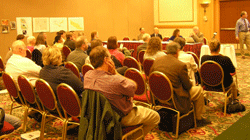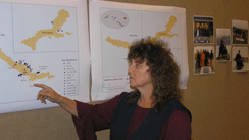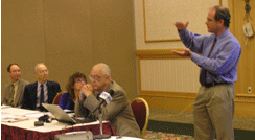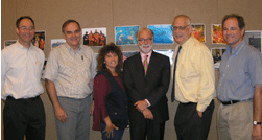




CRESP ANSWERS TO QUESTIONS FROM STAKEHOLDERS
CRESP
Briefing on the Amchitka Report
Anchorage Alaska
August 1, 2005
CRESP held public meetings in Anchorage, Alaska to present the results of its Amchitka independent assessment study on the evening of August 1 and the morning of August 2, 2005. (View Full Amchitka Final Report and CRESP Presentation at the Briefing) The August 1st CRESP presentation was followed that evening by an hour and a half of questions from the audience; and, as planned, a second and more informal open session for additional questions was held for about four hours the next morning.
About 70 persons including members of the press attended one or the other, or both of these meetings. For those who could not attend the meetings, we provide below some of the key questions CRESP was asked and the answers provided in these meetings.
AMCHITKA STAKEHOLDER QUESTIONS
1. What
were the Major Conclusions About Food Safety from this Study?
2. How can
You Say the Foods are Safe, if you Haven't Tested All Foods?
3. How can
you Say the Foods are Safe if you Only Sampled in One Season, in One Year?
4. How can
you be confident that your sampling didn't miss a seepage point?
5. Why Didn't
You Sample Salmon?
6. What about
Marine Mammals?
7. Were the
Detection Levels Achieved in the CRESP Analysis Low Enough to Be Protective?
8. How do
your Study's Data Relate to Concerns about Worker Risk?
9. What Happens
if there is a Major Earthquake out at Amchitka?
10. How
Will I Know if Things Change at Amchitka?
1.
What were the Major Conclusions About Food Safety from this Study?
The main conclusion is that the radionuclide levels in human foods are well
below the public health guidance levels. Although we did not test every food,
we tested foods in the different trophic levels.
We also found that
there was a wide range of organisms in the intertidal and subtidal habitats
around Amchitka that could be at risk if there was radionuclide seepage. A combination
of sedentary and mobile organisms at different trophic levels can be used in
the future as bioindicators of possible radionuclide seepage.
We did not find local discharges of freshwater onto the ocean floor, nor did
we find any freshwater flows through geological faults into the ocean. Thus,
we did not find any evidence that freshwater was currently providing a more
rapid pathway for carrying radionuclides out into the ocean.
2.
How can You Say the Foods are Safe, if you Haven't Tested All Foods?
It is never possible to test all foods because of the vast number of species
that are available, many of which are eaten by people. Instead, we developed
a sampling plan that included organisms at different trophic levels on the food
chain. These organisms are representative of other species at the same level
in the food chain. For example, we expected that the levels of radionuclides
would be similar among different species of algae, and would be similar among
different species of fish, and would be similar among different species of birds.
We found this to be the case.
We used information provided by Aleutian/Pribilof Island Association (A/PIA)
on the species consumed in the Aleut villages to decide which species to collect.
In the summer of 2003, before our collecting expedition, we held public meetings
in Unalaska, Nikolski, and Atka to show citizens there the tentative list of
species to be sampled, and ask them what other species we should include. We
also asked people on Adak whether there were other species we should add. These
discussions resulted in our adding another species of algae, Octopus, and a
number of different fish.
3.
How can you Say the Foods are Safe if you Only Sampled in One Season, in One
Year?
Our data are from one time period, in one year - and they reflect that time
period. However, radionuclides accumulate in organisms, and the levels we found
represent cumulative exposure over the lifetime of the organisms. Some of the
fish we collected can live for 50 (Halibut) to 100 years (some species of rockfish).
Some of the fish (Rock Greenling) have very small home ranges and reflect local
exposure in the marine environments near the test shots, while others represent
a larger area (Halibut, Pacific Cod).
Our testing results will serve as a baseline for any testing that is accomplished
in future years.
4.
How can you be confident that your sampling didn't miss a seepage point?
Sampling can never be universal. After examining the Amchitka history, geological
information and conferring with people who had previous experience at Amchitka,
we chose sampling areas closest to the most likely point for contamination to
move from the cavities to the sea. We then established sampling transects on
both sides of those points in an effort to maximize the likelihood that we would
find seepage if it were occurring.
5.
Why Didn't You Sample Salmon?
Salmon were on the original list of target species developed by CRESP in the
Amchitka Science Plan. However, we were advised by biologists from the Alaska
Department of Environmental Conservation and by people who had worked on the
terrestrial assessment of radionuclides conducted on Amchitka that salmon are
rare on Amchitka. The Salmon Run at Amchitka may be small or non-existent because
there are no good spawning streams for Salmon. The streams near the test shots
do not flow into the sea, but drop over bluffs or steep slopes. Further, when
we traveled around Amchitka, we found no Salmon, although our Aleut fishermen
were looking for them. The original studies conducted by scientists at Amchitka
in the 1970s also failed to find salmon in any numbers.
We did however find Dolly Varden, another species that, like salmon, typically
lives in the ocean and enters streams to spawn. We were able to collect Dolly
Varden from the creek near the Amchitka airfield. The levels of cesium in Dolly
Varden were low and were well below any human health risk.
6.
What about Marine Mammals?
Marine mammals were on our original target species list in the Amchitka Science
Plan - to be collected by the Aleut team. However, it became clear that the
Aleut hunters could participate in collecting samples for this study only if
they were with us on our ship. Amchitka is too far from the nearest villages
at Adak, NOAA determined that if Aleuts collected marine mammals for CRESP to
be used for chemical analysis, they could not do so without scientific collecting
permits, which required 2 years to obtain.
We decided to take a food chain approach to marine mammals, and collect the
food items that marine mammals eat (such as Sea Urchins, fish). The levels of
cesium and other key radionuclides were low or below detection levels in the
foods eaten by marine mammals.
The Aleut hunters on the expedition with us did take one Stellar Sea Lion as
part of their own subsistence hunt. They butchered it, and froze the meat to
take back to their villages. They then wrote to the Museum at the University
of Alaska (Fairbanks) and asked that the liver and meat they sent there be analyzed
for radionuclides. They wanted to know if it was safe for them to eat the Sea
Lion meat. The Museum then asked CRESP to perform this analysis. The analysis
showed that levels of cesium were very low and well below any levels that would
cause harm to the Sea Lions themselves, or to people who consume them.
7.
Were the Detection Levels Achieved in the CRESP Analysis Low Enough to Be Protective?
Yes. We designed our analysis plan so that our detection limits were at background
levels, and were typically 100 times or more below health risk standards. The
levels we actually found in marine biota were very low. However, if radionuclide
detection instruments are sensitive enough, they can detect some levels of many
radionuclides in all biota - either from naturally-occurring sources or from
radioactive fallout associated with the atmospheric nuclear detonations conducted
before atmospheric nuclear tests were banned. We wanted to detect radionuclide
levels in biota so that we would be able to determine which species accumulate
specific radionuclides (even though they were very low) so that they could be
used for future monitoring. Thus, for cesium-137 we analyzed some samples of
Aleut subsistence foods using 1000 gram samples, and counting for 3-6 days.
Why did we keep testing until we got detects? It was essential to have detectable
levels for some marine organisms so that we could provide information that would
be useful for DOE to design a biomonitoring plan for the future. It is the organisms
that accumulate some measurable levels that should be used as a baseline for
biomonitoring. Significant changes from baseline levels would provide the earliest
warning if there were ever a problem with radionuclide seepage into the marine
environment.
8. Do your Study's Results Relate to Concerns about
Worker Risk?
No. The CRESP study was designed to examine radionuclides in marine biota at
the present time. The study does not deal with any hazards that workers may
have encountered before, during or after the nuclear testing, nor does it provide
information about the remediation workers who were on Amchitka in recent years.
There are many ways workers may have been exposed, but the CRESP study did not
collect any data that were relevant to this question.
9.
What Happens if there is a Major Earthquake out at Amchitka?
CRESP was not funded to do seismic work at Amchitka, so our study provides no
new data on this issue per se. The Science Plan did call for establishing a
new monitoring capability at the island, but this was one of many proposed studies
not included in the list of funded research. Clearly for the public, the possibility
that a major geological event at Amchitka might significantly accelerate radionuclide
release is a source of anxiety and concern. Because a baseline of data on radionuclide
levels in biota now exists, a long-term biomonitoring program could, and in
CRESP's judgment should, establish triggers for "special" sampling
and analysis after a major seismic event. Such a trigger would probably be based
on some combination of the magnitude of the event and its proximity to the Amchitka
test sites. Establishing the conditions under which such special sampling should
take place after a seismic event should take into account the ability of such
an event to accelerate release of radionuclides to the marine environment and
biological information about the speed with which a radionuclide release would
move up the food chain and contaminate foods.
10.
How Will I Know if Things Change at Amchitka?
If the primary issue is food safety, then the way to know if things change at
Amchitka is to conduct periodic monitoring of the radionuclide levels in marine
organisms. It is essential to develop a biomonitoring plan based on the data
generated in the CRESP study. The species used for biomonitoring should be those
species that had detectable levels of radionuclides, even though they were very
low. Development of a biomonitoring component for the Long-term stewardship
at Amchitka is important.

Questions or Comments? cresp@eohsi.rutgers.edu